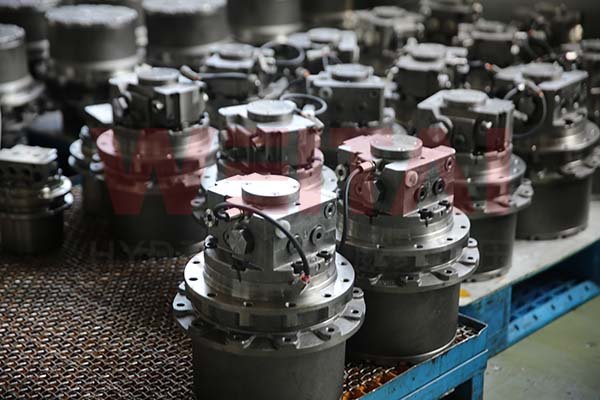Do you know the 2 speed final drive or the 2 speed rear axle? Do you know what machines or vehicles the 2 speed final drives can be used for? In this post, WEITAI will give you a detailed introduction about it. Follow me to dive in.
What Is a 2 Speed Final Drive?
A 2-speed final drive, also known as a 2-speed rear axle, is a type of drivetrain component used in some vehicles, particularly in heavy-duty or off-road applications. The main purpose of a 2-speed final drive is to provide the vehicle with two different gear reduction ratios, allowing it to operate effectively in a wider range of driving conditions and terrain. The key features of a 2-speed final drive are as follows.
- Two gear reduction ratios
Low gear ratio: Provides a higher level of torque for improved traction and low-speed capabilities, such as climbing steep hills or navigating rough terrain.
High gear ratio: Offers a lower level of torque but higher speed for more efficient highway driving.
- Gear shifting mechanism
The driver or a control system can switch between the low and high gear ratios, depending on the driving conditions and requirements.
- Robust construction
2-speed final drives are typically found in heavy-duty vehicles like trucks, off-road vehicles, and military vehicles, where they need to withstand high loads and stresses.
The ability to switch between the low and high gear ratios gives the vehicle greater flexibility and versatility. The low gear ratio provides superior low-speed performance and traction, while the high gear ratio improves fuel efficiency and top-end speed on the highway. This can be particularly useful for vehicles that need to handle a wide range of driving conditions, such as towing heavy loads, traversing rough terrain, or maintaining high-speed highway driving.

2 Speed Final Drive VS single-speed Final Drive
The key differences between a 2-speed final drive and a single-speed final drive in terms of performance and efficiency are:
- Versatility and adaptability
2 speed final drive: Offers two different gear reduction ratios, allowing the vehicle to better adapt to various driving conditions and load requirements. This provides improved traction and low-speed capabilities in low gear, as well as better fuel efficiency and top-end speed in high gear.
Single-speed final drive: Provides a fixed gear reduction ratio, which is a compromise between low-speed performance and high-speed efficiency.
- Traction and low-speed performance
2 speed final drive: The low gear ratio allows for higher torque delivery to the wheels, improving traction and low-speed capability, such as when climbing steep hills or navigating rough terrain.
Single-speed final drive: The fixed gear ratio may not provide as much low-speed torque, potentially leading to reduced traction and performance in challenging situations.
- High-speed efficiency and top speed
2 speed final drive: The high gear ratio is optimized for highway driving, reducing engine rpm and improving fuel efficiency at higher speeds.
Single-speed final drive: The fixed gear ratio may result in higher engine rpm and lower fuel efficiency at highway speeds, limiting the top speed of the vehicle.
- Gear shifting and control
2 speed final drive: Allows the driver or a control system to manually or automatically switch between the low and high gear ratios, providing more control over the vehicle’s performance.
Single-speed final drive: Cannot adjust the gear ratio, limiting the driver’s control over the vehicle’s performance characteristics.
In summary, the 2 speed final drive offers greater versatility, improved traction, and low-speed performance, as well as better high-speed efficiency and top-end speed compared to a single-speed final drive. This makes the 2 speed final drive more suitable for applications that require a broad range of driving conditions, such as heavy-duty, off-road, or towing applications.

Typical Applications of 2-Speed Final Drive
1. 2 speed final drive systems are typically found in the following types of vehicles and applications:
- Heavy-duty trucks and commercial vehicles
Tractor-trailers
Dump trucks
Cement mixers
Fire trucks
Garbage trucks
- Off-road and all-terrain vehicles
Military vehicles (e.g., Humvees, armored personnel carriers)
Construction equipment (e.g., loaders, excavators, bulldozers)
Agricultural equipment (e.g., tractors, harvesters)
All-terrain vehicles (ATVs) and side-by-side UTVs
- Recreational off-road vehicles
Jeeps and 4×4 SUVs
Rock crawlers
High-performance off-road vehicles
Some high-performance sports cars and supercars
To provide a balance between low-speed torque and high-speed efficiency
2. The key reasons why 2 speed final drive systems are commonly used in these applications include:
- Improved traction and low-speed performance
The low gear ratio provides the necessary torque and tractive effort for navigating steep inclines, soft terrain, or heavy loads.
- Enhanced high-speed efficiency
The high gear ratio reduces engine rpm and improves fuel efficiency during highway driving or high-speed operation.
- Versatility and adaptability
The ability to switch between low and high gear ratios allows the vehicle to better handle a wide range of driving conditions and requirements.
- Durability and robustness
The heavy-duty construction of 2 speed final drives is suitable for the high loads and stresses encountered in off-road, commercial, and high-performance applications.

Hot Topics and Trends Related to 2 Speed Final Drive
Here are some of the key hot topics and trends related to 2 speed final drive systems.
- Increased adoption of electric and hybrid vehicles
As the automotive industry shifts towards electrification, 2 speed final drives are being integrated into electric and hybrid vehicles to optimize performance and efficiency.
The combination of a 2 speed final drive with an electric motor can provide exceptional low-speed torque and high-speed efficiency.
- Advancements in control systems and automation
Manufacturers are developing more advanced control systems and algorithms to automatically manage the shifting between the low and high gear ratios.
This includes the integration of sensors, microcontrollers, and sophisticated shift-scheduling algorithms to optimize performance and efficiency.
- Improvements in durability and reliability
Ongoing engineering efforts are focused on enhancing the robustness and reliability of 2 speed final drive components to meet the demands of heavy-duty and off-road applications.
This includes the use of advanced materials, improved manufacturing techniques, and enhanced lubrication systems.
- Integration with other drivetrain technologies
2 speed final drives are being increasingly integrated with other advanced drivetrain technologies, such as electronic limited-slip differentials, torque vectoring systems, and all-wheel-drive systems.
This integration aims to further enhance traction, stability, and overall driving dynamics.
- Compliance with emissions and efficiency regulations
Stricter emissions and fuel efficiency regulations are driving the development of 2 speed final drives that can help vehicles meet these standards, particularly in commercial and heavy-duty applications.
- Customization and specialized applications
Manufacturers are offering more customization options for 2 speed final drives, allowing customers to optimize the gear ratios and other parameters to suit their specific needs and requirements.
This includes specialized applications in the military, construction, and agricultural sectors, where the versatility of the 2 speed system is highly valued.
In Summary
The 2 speed final drive is often integrated into the vehicle’s overall drivetrain system, working in conjunction with other components like the transmission and transfer case to optimize power delivery and performance.



